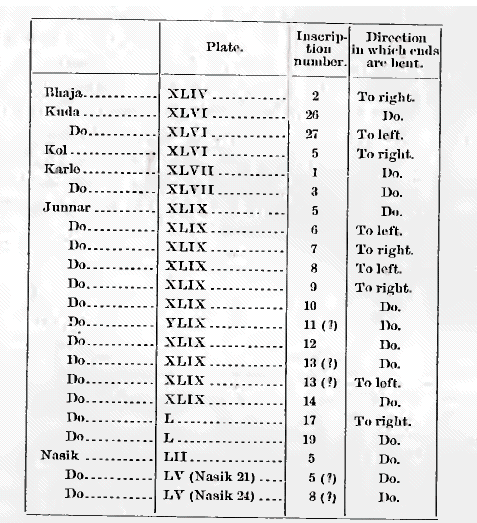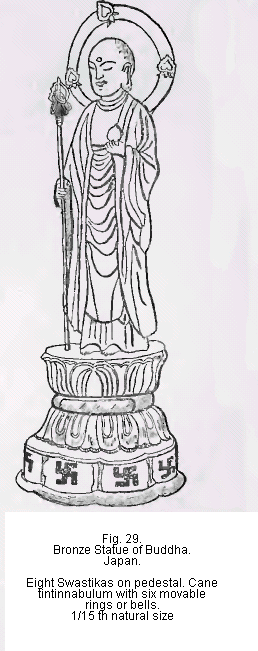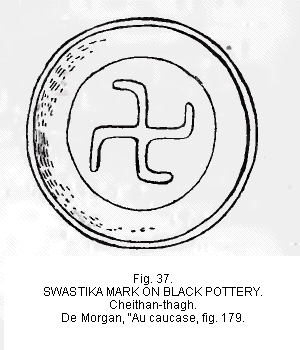

The Swastika
Dispersion of the Swastika

Chantre (2) says:
I remind you that the (East) Indians, Chinese, and Japanese employ the Swastika, not only as a religious emblem but as a simple ornament in painting on pottery and elsewhere, the same as we employ the Greek fret, lozenges, and similar motifs in our ornamentation. Sistres [the staff with jingling bells, held in the hand of Buddha, on whose base is engraved a row of Swastikas, fig. 29 of
 present
paper] of similar form and style have been found in prehistoric Swiss
lake dwellings and the bronze age. Thus the sistres and the Swastika
are brought into relation with each other. The sistres possibly
relate to an ancient religion, as they did in the Orient; the Swastika
may have had a similar distinction.
present
paper] of similar form and style have been found in prehistoric Swiss
lake dwellings and the bronze age. Thus the sistres and the Swastika
are brought into relation with each other. The sistres possibly
relate to an ancient religion, as they did in the Orient; the Swastika
may have had a similar distinction.De Mortillet and others hold the same opinion. (3)
BABYLONIA, ASSYRIA, CHALDEA, AND PERSIA.
Waring (4) says, “In Babylonian and Assyrian remains we search for it [the Swastika] in vain.“ Max Müller and Count Goblet d’Alviella are of the same opinion. (5)
Of Persia, D’Alviella (p.51), citing Ludwig Müller,(5) says that the Swastika is manifested only by its presence on certain coins of the Arsacides and the Sassanides.
It is reported by various authors that the Swastika has never been found in Phenicia, e.g. Max Müller, J.B. Waring, Count Goblet d’Alvieall. (6)
Ohnefalsch-Richter (7) says that the Swastika is not found in Phenicia, yet he is of the opinion that their emigrant and commercial travelers brought it from the far east and introduced it into Cyprus, Carthage, and the north of Africa. (See p. 796.)
Lycaonia.
Lempreire, in his Classical Dictionary, under the above title, gives the following:
A district of Asia Minor forming the southwestern quarter of Phrygia. The
 origin of its name and inhabitants, the Lycaones, is lost in obscurity.
* * * Our first acquaintance with this region is in the relation of the
expedition of the younger Cyprus. Its limits varied at different times.
At first it extended eastward from Iconium 23 geographical miles, and
was separated from Cilicia on the south by the range of Mount Taurus,
comprehending a large portion of what in later times was termed Cataonia.
origin of its name and inhabitants, the Lycaones, is lost in obscurity.
* * * Our first acquaintance with this region is in the relation of the
expedition of the younger Cyprus. Its limits varied at different times.
At first it extended eastward from Iconium 23 geographical miles, and
was separated from Cilicia on the south by the range of Mount Taurus,
comprehending a large portion of what in later times was termed Cataonia.
Count Goblet d’Alviella, (8) quoting Perrot and Chipiez, (9) states that the Hittites introduced the Swastika on a bas-relief of Ibriz, Lycaonia, where it forms a border of the robe of a king or priest offering a sacrifice to a god.
M.J. de Morgan (the present director of the Gizeh Museum at Cairo), under the direction of the French Government, made extensive excavations and studies into the French government, made extensive excavations and studies into the prehistoric antiquities and archaeology of Russian Armenia. His report is entitled “Le Premier Age del Metaux dans I’Armenie Russe.” (10) he excavated a number of prehistoric cemeteries, and found therein various forms of crosses engraved on ceintures, vases, and medallions. The Swastika, though present, was more rare. He found it on the heads of two large bronze pins (fig. 37) from the prehistoric tombs. The bent arms are all turned to the left, and would be the Suavastika of Prof. Max Müller.
ENDNOTES:
1. Trubner & Co., London, 1883, 99. 140,pl 60. [Back]
2. “Age du Bronze,” pt. 1, p.206. [Back]
3. “Musce Prehistorique,” pl.98; “Notes de l’Origine Orientale de la Metallurgie,: Lyon, 1879; “L’Age de la Pierre et du Bronze dans ‘;Asie Occidentale,” Bull. Soc. d’Anthrop., Lyon, I, fasc. 2, 1882; Bull. Soc. d’Anthrop. D’Anthrop. De Paris, 1886,pp.299,313, and 314. [Back]
4. “Ceramic Art in Remote Ages.” [Back]
5. “Det Saakaldte Hagebors,” Copenhagen, 1877. [Back]
6. “La Migration des Symboles,” pp. 51,52. [Back]
7. Bull. De la Soc. d’Anthrop., December 6, 1888, xi, p. 671. [Back]
8. “La Migration des Symboles,” p. 51. [Back]
9. “Histoire de l’Art dans i’Antiquite,” iv. [Back]
10. “Mission Scientifique an Caucase.” [Back]
<< Previous Page Next Page >>
© 2004-2007 Northvegr.
Most of the material on this site is in the public domain. However, many people have worked very hard to bring these texts to you so if you do use the work, we would appreciate it if you could give credit to both the Northvegr site and to the individuals who worked to bring you these texts. A small number of texts are copyrighted and cannot be used without the author's permission. Any text that is copyrighted will have a clear notation of such on the main index page for that text. Inquiries can be sent to info@northvegr.org. Northvegr™ and the Northvegr symbol are trademarks and service marks of the Northvegr Foundation.

|